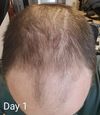community The Impact of Hair Loss: Comparing President Biden at Ages 25 and 30
Joe Biden aged significantly between ages 25 and 30, with noticeable changes in hair and facial features. He had a hair transplant, but it's unclear if he used Minoxidil or Finasteride.
